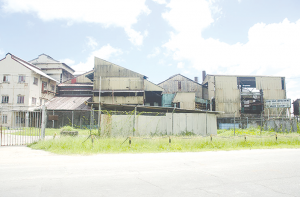– but that may take some doing, as factory is ‘beyond repair’
By Naomi Parris
WHILE on the campaign trail, the incumbent People’s Progressive Party/Civic (PPP/C) had committed to revitalizing the sugar industry and reopening those sugar estates across Guyana that had been closed. Following his appointment, new Minister of Agriculture Zulfikar Mustapha said that the government is committed to fulfilling the promises the Party made in its Manifesto and on the campaign trail while in opposition.
And in keeping with that commitment, he said that the government will be conducting a series of researches and surveys to help guide it on the way forward.
“The reopening of the estates, “ he said, “will depend on when we finish the studies and see what exists in the government, because right now, you have a pandemic in the country, and the world reality is different. But we are committed to these promises that we have in our Manifesto.”
He however warned that the Wales Estate, a once booming estate back in its prime, will be the most difficult to reopen, since the factory has been dormant for some time and is in a deplorable state.
During a recent visit to the Estate, the Guyana Chronicle was told by the Officer in Charge, Mr. Charles Browne that several former sugar workers have been enquiring about what is to become of the estate, and that while many of them who live in Region Three (Essequibo Islands-West Demerara) where the estate is located, would have moved on and taken up various other careers, there are still a few hardy souls who are open to returning to work there, since it is closer to where they live. However, there is not much hope, since the state of the estate’s factory is beyond repair.
He said that in order to restore the estate, it will take a team effort from the workers as well as the government.
“I’m in favour of people going back to work and people getting work, because all were affected, including myself,” Browne said. “But when they go to work a fair day’s work, some operations require seven days, and there might be problems, because some of the workers might not get work during that time, and it throws your programme back,” he added.
He further stated that given the deplorable state of the factory at the Wales Estate, it is not likely that it can be restored and get back up and running as it once did in its glory days. He said that unlike Wales, other estates may stand a better chance at restoration and reopening, since they have functioning factories.
THE GLORY DAYS

Looking back over the years, Browne said, “Wales, in its glory days… I can tell you there were incentives that used to be paid according to production, and Wales was way at the top, with a day’s pay, or a weekly incentive in a particular crop. They may be 20 weeks in the second half; 15 weeks in the first half, and Wales would manage 90% at the time to surpass targets.”
Browne noted that Wales could have held its own with sister estates in Berbice and Uitvlugt, which were the pillars of the sugar industry in Guyana.
“It was extremely productive by comparison to its sister estate, Uitvlugt, but as time went by, the soils started to become somewhat depleted; come from years of mono-cropping,” Browne said, adding: Some of the problems we had to deal with is that we had to change some of the cane varieties at the time.
“The way the factory used to extract was very good; 11 tons of cane to make a ton of sugar… Wales could have been compared to the Berbice Estates, which were the most productive estates at the time. Sadly though, as the years went by, production started to decline. Part of it had to do with the labour; less and less persons wanted to do manual labour.”
Browne disclosed that the lack of field workers, along with the decline of sugar prices across the country saw the Wales Estate becoming a less profitable venture to many.
DIVERSIFICATION
Nevertheless despite its closure, the estate has been operational, with diversification plans moving apace at the facility, where rice, cash-crops, coconuts, ‘provision’, citrus and animal farming are just a few of the industries that have already been established.
Though activities related to the diversification initiative were slow when the estate first closed back in December 2016, there have since been massive developments.
“The project began in the second half of 2017 with around 200 acres; we were new to the thing then. We had to convert lands from cane beds to rice beds; we had some problems because of too much soil movement, so we had to modify. W started at 200 acres, but currently we have 510 acres, with some more lands set aside for expansion,” Browne said.
He said that the project has been growing from strength to strength, and the facility has managed to turn that growth into a profit so as to be able to purchase more machinery for ground and water works at the estate.



.jpg)









